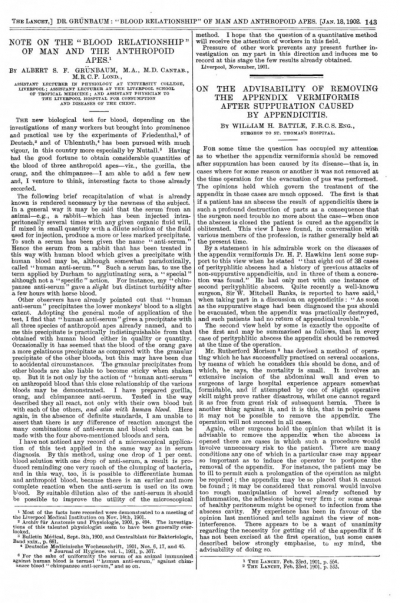Morris Goodman’s 1963 review entitled Man’s place in the phylogeny of primates as reflected in serum proteins is a well-deserved classic. In it he cites Nuttall (1904) as a pioneer of the use of serology. That citation refers to a volume entitled Blood Immunity and Blood Relationship. A demonstration of certain blood-relationships amongst animals by means of the precipitin test for blood. I have been meaning to chase this down for years, but something more urgent but less interesting always seemed to get in the way. However, last month I finally got hold of and looked through George Nuttall’s book.
The precipitin reaction the book title refers to, which is the result of mixing experimentally generated antiserum with a serum sample, was first reported by Kraus in 1897. The first use of the precipitin reaction to investigate the relationships among animals was by Nuttall (1901). These experiments, plus many others by Nuttall and two colleagues, G.S. Graham-Smith and T.S.P. Strangeways (who later became the Director of the Research Laboratory that bears his name), are reviewed in Nuttall’s 1904 monograph.
The experimental system used by Nuttall and his colleagues involved multiple injections of serum or defibrinated blood into the peritoneal cavity of rabbits. The rabbits were killed, the collected blood allowed to clot, antiserum was prepared from it and this antiserum was then mixed with the serum of the comparator animal. In Nuttall’s own words, if the rabbit had been injected with modern human blood, “the serum of this rabbit will be found to have acquired the remarkable property of producing a precipitation immediately on its being added in small quantity to a dilution of human blood-serum. If allowed to rest, the precipitated substance gravitates to the bottom of the tube. I have now tested upwards of 230 bloods obtained from animals of all classes of vertebrates with such anti-serum for human blood, and have, with the single exception of monkey bloods, obtained negative results throughout” (Nuttall 1901, pp. 150-1).
Nuttall suggests that the first use of antiserum generated in response to administering the serum of apes to assess their relationships with modern humans was by Grünbaum (1902). Albert Grünbaum, who was a physiologist and a clinician at The Liverpool Hospital for Consumption and Diseases of the Chest, had “the good fortune to obtain considerable quantities of the blood of three anthropoid apes” (ibid, p. 143) and he used some of it to prepare antiserum to chimpanzee, gorilla, and orangutan serum. He reported his results in a short letter to a medical journal called The Lancet and he wrote thus, “I find that ‘human anti-serum’ gives a precipitate with all three species of anthropoid apes already named, and to me this precipitate is practically indistinguishable from that obtained with human blood either in quality or quantity. Occasionally it has seemed that the blood of the orang gave a more gelatinous precipitate as compared with the granular precipitate of the other bloods, but this may have been due to accidental circumstances”. Later in the short article he writes that, “in the absence of definite standards, I am unable to assert that there is any difference of reaction amongst the many combinations of anti-serum and blood which can be made with the four above-mentioned bloods and sera” (ibid, p. 143). This is almost certainly the first use of serology to compare Homo with Pan, Gorilla and Pongo and it is remarkable that Grünbaum detected the difference between the reactions of Pan and Gorilla, on the one hand, and Pongo, on the other. Grünbaum went on to write that he hoped others would pursue “a quantitative method” because, “pressure of other work prevents any present further investigation on my part”.
In an article that took little more than a single column of The Lancet (see the image below), Grünbaum laid a strong claim to be the pioneer of comparative primate serology. Grünbaum sounds the sort of scientist who would have been delighted with the way Morris Goodman subsequently developed his principle and refined his serological methods to the extent that the latter was able to use antibody-antigen reactions to successfully discriminate among the great apes and modern humans.
References
Goodman, M. (1963) Man’s place in the phylogeny of the primates as reflected in serum proteins. In: Classification and Human Evolution, Washburn, S., ed., pp. 204–34. Aldine Publishing Company, Chicago, IL.
Grünbaum, A.S.F. (1902) Notes on the “blood relationship” of Man and the Anthropoid apes. The Lancet Jan. 18th: 143.
Nuttall, G.H.F. (1901) The new biological test for blood in relation to zoological classification. Proc. Roy. Soc. 69: 150-153.
Nuttall, G.H.F. (1904) Blood Immunity and Blood Relationship. A demonstration of certain blood-relationships amongst animals by means of the precipitin test for blood. Cambridge University Press, Cambridge, UK.


